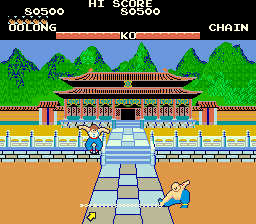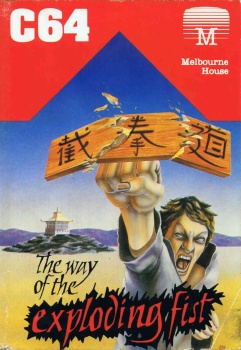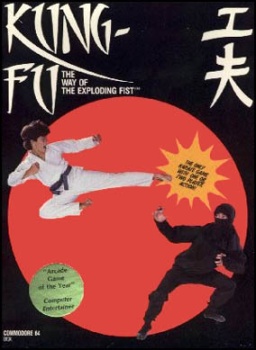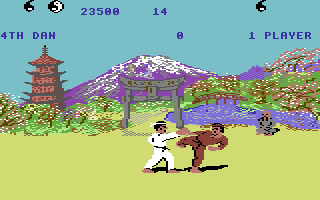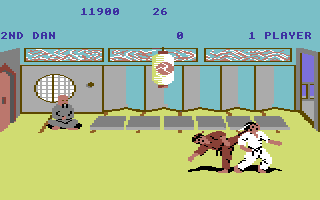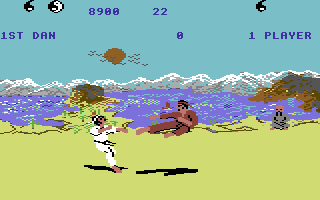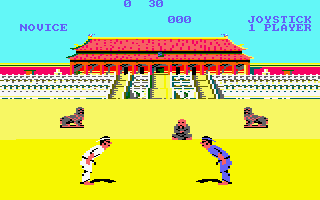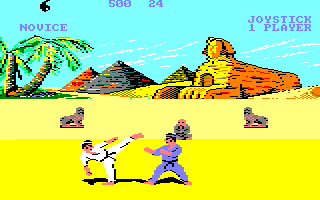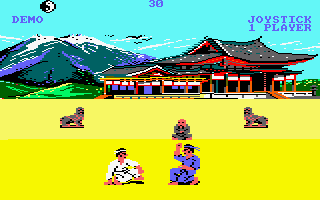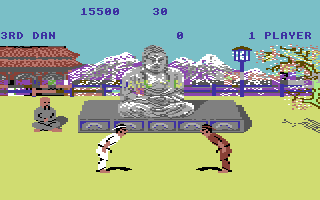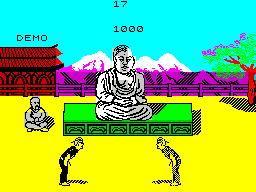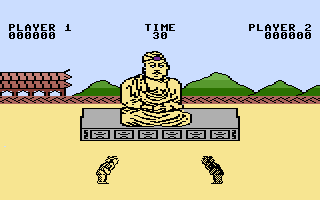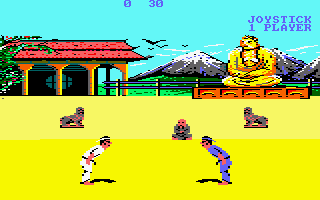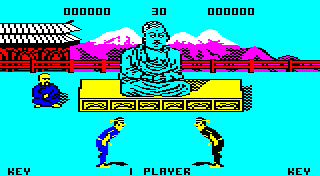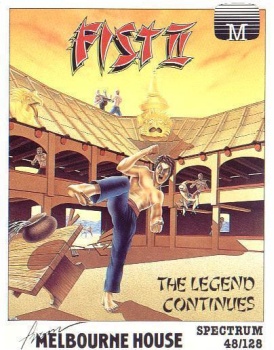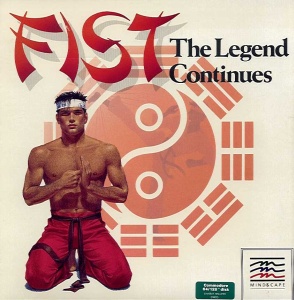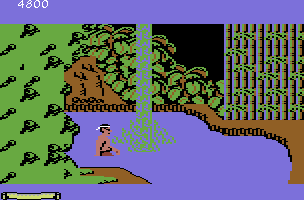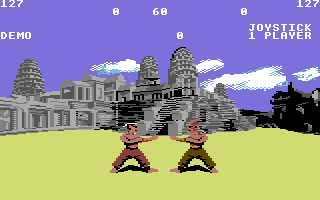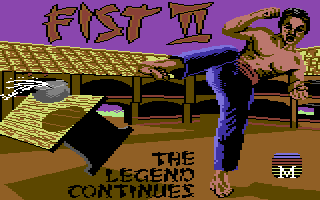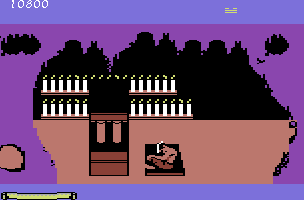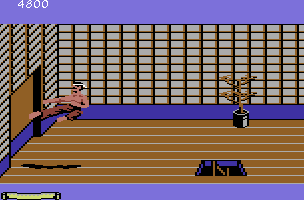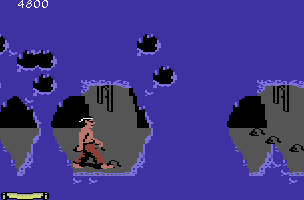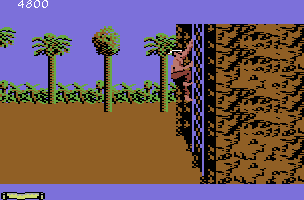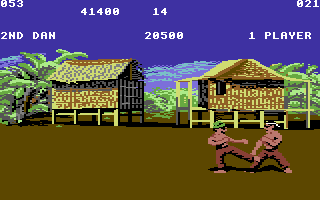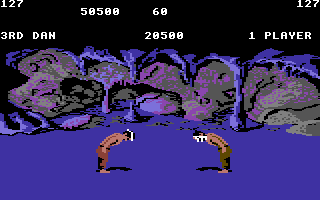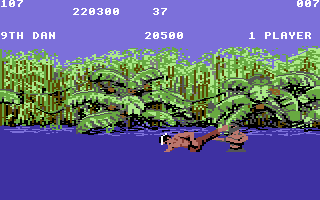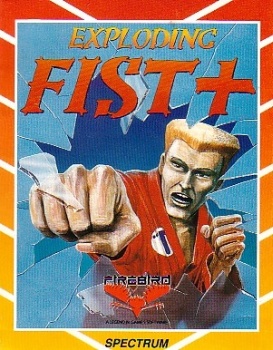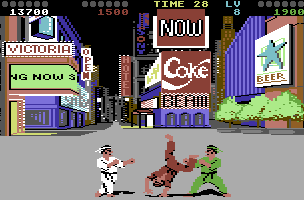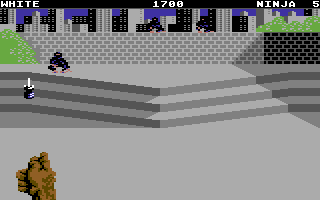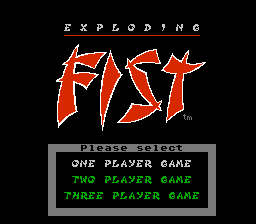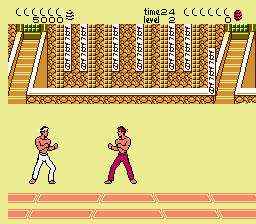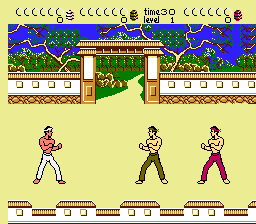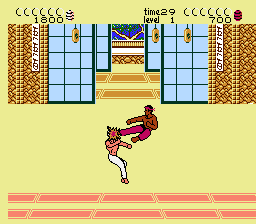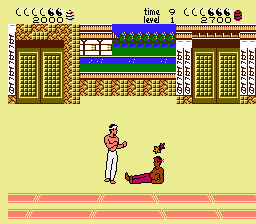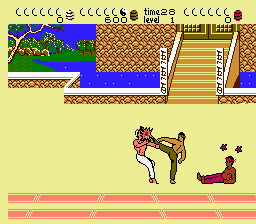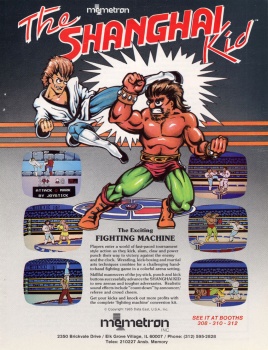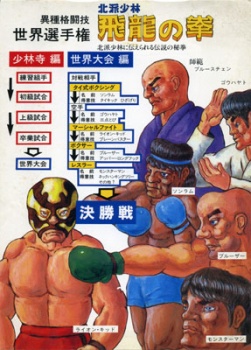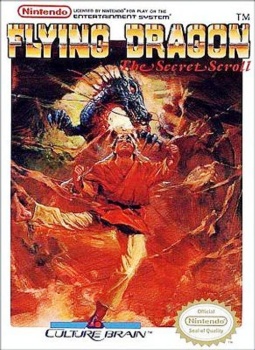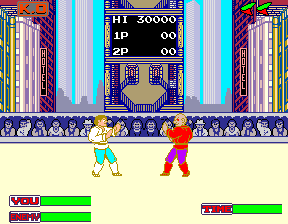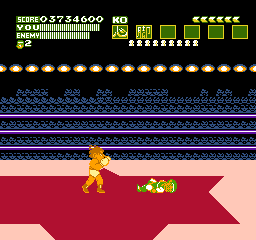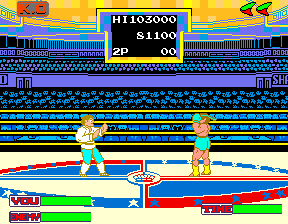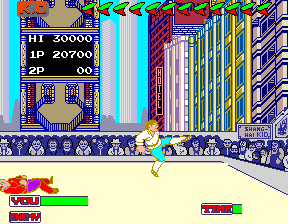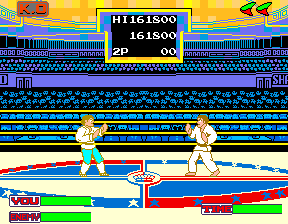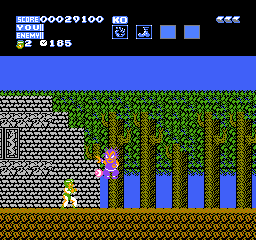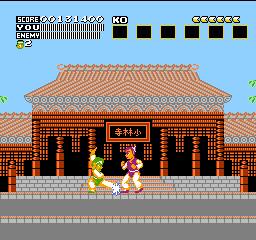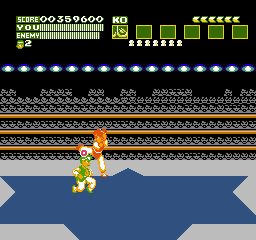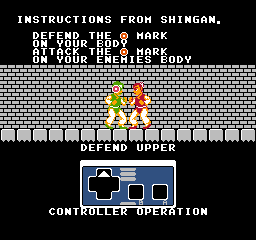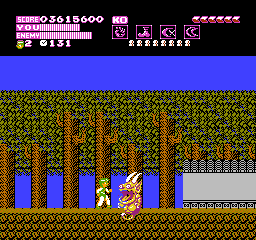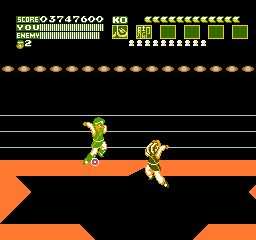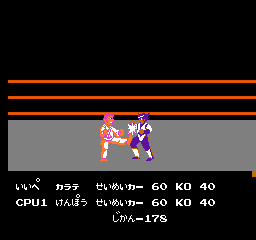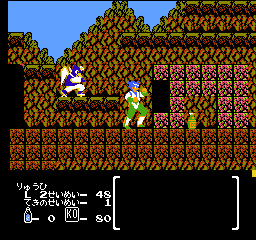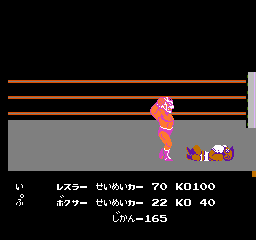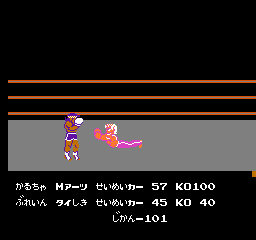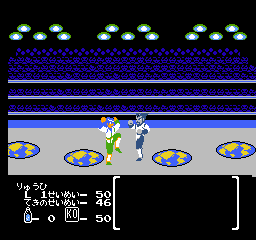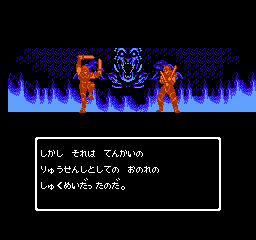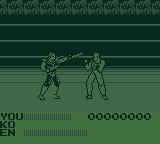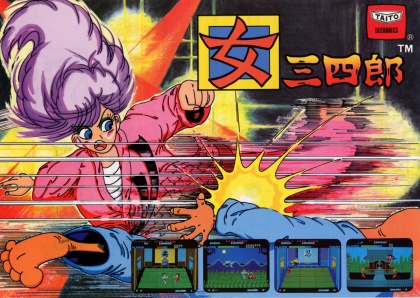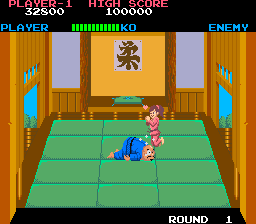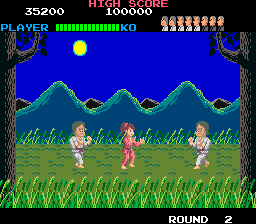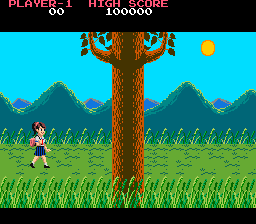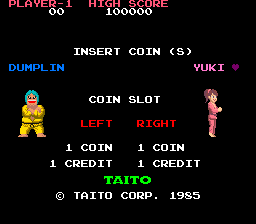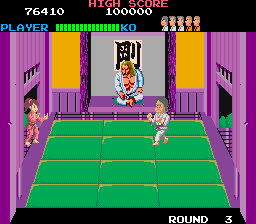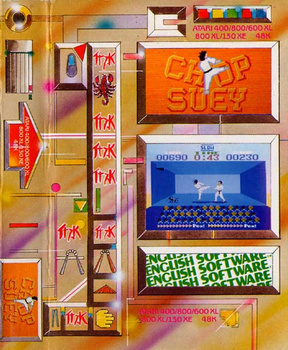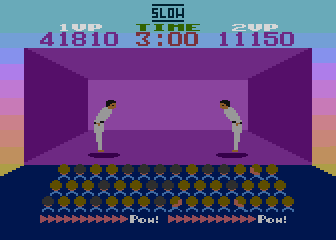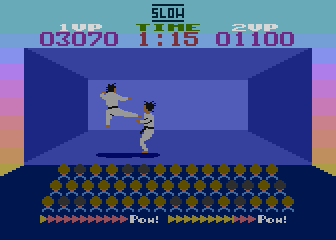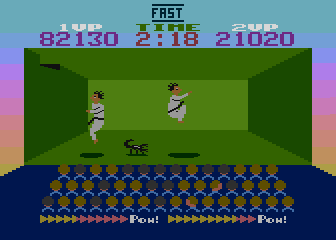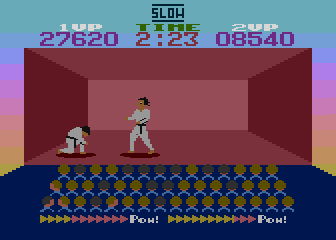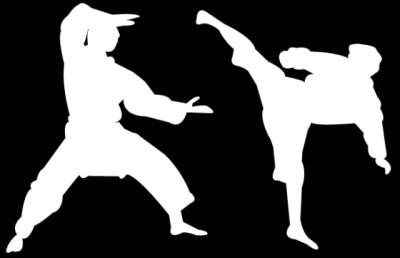
Pre-Street Fighter II Fighting Games
|
Page 1: |
Page 2: |
Page 3: |
Page 4: |
Page 5: |
|
Page 6: |
Page 7: |
Page 8: |
Page 9: |
Page 10: |
|
Page 11: |
Page 12: |
While Yie Ar Kung-Fu's mechanics owe a fair share to Karate Champ, its innovations lie in a different field: Generic Karate Guy 1 and Generic Karate Guy 2 were the stars of almost every fighting game at the time, but Yie Ar Kung-Fu features a colorful cast of characters that look like it was ripped straight from a boisterous 1970s Hong Kong flick, each of them with individual characteristics and abilities. The duels are accompanied by the most stereotypical tunes of "Chinese music" one could imagine. The player always plays the role of Oolong, who is out for revenge after his father has been killed by the tournament champion in the final battle. Character select screens were still a thing of the future, matches for two human players the privilege of Generic Karate Guys in other games.
The Way of the Exploding Fist - Commodore 64, Amstrad CPC, Commodore Plus/4, BBC Micro, ZX Spectrum (1985)
The Way of the Exploding Fist marks the beginning of Karate Champ's influence in the West. Gregg Barnett quite literally conceived his game as an adaption of "the Karate arcade game" - there was only one at the time - for home computers, as he revealed in Your Computer issue 8/1985. While it may be no more than a Karate Champ clone itself, Exploding Fist is one the most plagiarized games ever made. Most pre-SFII fighting games for home computers are virtually rehashes of this one. Sometimes other games literally contained identical animations and blatantly obviously redrawn versions of the same sprites.
Moves are performed by pressing a direction alone or in conjunction with the attack button. This control system allows for about a dozen attacks, the ability to walk and jump forward and backward. You can block and evade, but these moves are not reliable due to the game's very specific hit detection. Like in Karate Champ, hits are rewarded either with a full point or a half point, and the first to reach two points wins.
The major complaint with Exploding Fist is the controls. Characters keep facing the same direction, even if the opponent moves past them. It's possible to turn around by executing any of the three attacks in that direction, but these moves can also be executed when already facing the opponent, turning the back on them. This can get quite annoying.
The game's visuals, on the other hand, are high end for the time. The animations are fluid and there are four different backgrounds with high levels of detail. Audio effects are outrageous. Exploding Fist utilizes Bruce Lee movie inspired effects like high pitched screams and kung-fu movie cracks.
There were a few ports of this game. The Commodore 64 version is by far the best with superior graphics and sound. The Amstrad CPC version only has one background (which is not seen in any of the other versions) and no music, but it is still better than any of the remaining versions. A bit later, there was also a "+" version released, which has nothing to do with the Exploding Fist+ covered below. Instead, is just the same as the original, only with four backgrounds to choose from. Two of these are based off backgrounds from the other versions, while the other two are entirely new. While all the other backgrounds have vaguely oriental motifs, one totally rips off the Egypt stage from International Karate. The ZX Spectrum has all the backgrounds, but of course its audiovisual capabilities are far below the C64, and the controls even less reliable. The BBC Micro and Commodore Plus/4 versions both have only one background, and don't look or play very good.
Quick Info:
|
Developer: |
|
|
Publisher: |
|
|
Designer: |
|
|
Genre: |
|
|
Themes: |
The Way of the Exploding Fist (Commodore 64)
The Way of the Exploding Fist (Commodore 64)
The Way of the Exploding Fist (Commodore 64)
Amstrad CPC Screenshots
Comparison Screenshots
Fist 2 offers two different playing mode: The first one tries to be kind of an adventure game, where the hero has to walk around a large branching area in search for mystical scrolls. This involves lot of excruciatingly slow walking along repetitive terrain, climbing ladders, jumping over pits, and occasionally fighting battles. These play exactly like the previous game, except with the point system replaced with a health bar, which is slowly replenished between fights. The hero can also meditate at shrines to heal, and this is where he has to get the scrolls with the according symbols.
The other mode is a 1-on-1 fighter just like the original, where the player fights against the enemies from adventure mode instead of the usual karate guy. There are four new backgrounds, one of which has the combatants fighting in waist-deep water, which means that no low attacks or jumps are possible.
Quick Info:
|
Developer: |
|
|
Publisher: |
|
|
Designer: |
|
|
Genre: |
Fist II: The Legend Continues (Commodore 64)
Fist II: The Legend Continues (Commodore 64)
Additional Screenshots
One of the most blatant clones of The Way of the Exploding Fist was International Karate, and Beam Software returned the favor with Eploding Fist+. So it was a knock off of IK+, a sequel to International Karate, which was a clone of The Way of the Exploding Fist, which, again, was a clone of Karate Champ. The main differences from The Way of the Exploding Fist are the changed point system (copied from IK+), and three active characters in each fight (also copied from IK+). It even steals the reduction to one single stage background from IK+! The bonus round where ninjas slowly approach and have to be taken out by throwing knives appears to be inspired by Sega's Shinobi, which had appeared in arcades the year before. The only new innovation is a cartwheel move that allows the fighters to get across the screen quickly.
The ZX Spectrum version, even though it loses fidelity as usual, is something special: It allows all three fighters to be controlled by human players. This feature made Fist+ the first fighter to allow more than two people to play at the same time.
Quick Info:
|
Developer: |
|
|
Publisher: |
|
|
Genre: |
Exploding Fist+ (Commodore 64)
Exploding Fist+ (Commodore 64)
In 1989, Beam Software also worked on an Exploding Fist for the NES. It was never published, but some ROMs made their way through unusual channels and dumps were released for download by Lost Levels in 2012. This version is quite different from the original game, or any other entry in the series. It uses both buttons, one for punches and jumps, and the other (predominantly) for kicks. But the general scheme of pressing them in combination with directions to execute moves still applies.
This version also takes some elements from Exploding Fist+, as it allows up to three players to compete. In single player mode, it's 1-on-1 matches, but two player mode always has a third combatant controlled by the CPU.
The game looks pretty good for an NES fighting game, with large, well-animated characters. There is a number of different backgrounds, although they all look rather similar, as if cut out from the same single scrolling stage. The background music is pretty exciting and very fitting, although it's still only one tune playing all the time. It's a shame that this wasn't released. Even though the gameplay is nothing special and the CPU is absolutely relentless, this would have been a nice addition to the NES library in 1989.
Quick Info:
|
Developer: |
|
|
Designer: |
|
|
Genre: |
Exploding Fist (NES)
Exploding Fist (NES)
Additional Screenshots
Hiryū no Ken was a long-living series by Culture Brain (Nihon Game by the time of the first release). The original arcade game, Shanghai Kid (Hokuha Syōrin Hiryū no Ken or 北派少林 飛龍の拳 in Japan) is still a pure fighting game. While fighting through a series of boxers, karate fighters, etc., a target briefly appears on either of the two characters seemingly at random. At this point a move can be executed by tapping the attack button and a direction to execute attacks (if the target is on the opponent) or just a direction for blocks (if the target is on the player). The matches end when a character's health meter or the timer are depleted.
The game takes the time to instruct the player at length, in the first fighting game tutorial ever. Even with that kind of guidance, it is very hard to execute an attack quickly enough. The worst part is a minor health loss for entering a command when there is no target on screen. This is obviously to prevent button mashing, but it's just so easy to do it by accident.
Shanghai Kid is notable for being the first fighting game to have a combo system. The combos are performed by button mashing at varying intervals when the game displays the word "rush." The combo results in the player character performing a series of strikes more or less identical to the custom combos from Street Fighter Alpha. It's also the first game to have a kind of counter system, although it only applies to high punches. When blocking such an attack, it's possible to work that into a body throw, which deals a lot more damage than standard punches and kicks. Another important video game first was the inclusion of special moves, although they are very primitive and are performed by tapping both punch and kick at the same time. When dealing damage, a "KO" bar fills at the top of the screen. When it is full, it starts flashing, and for a short while all button presses result in a flying spin kick, a precursor for later super moves.
Two years later, the game was followed by Hiryū no Ken: Ōgi no Sho (飛龍の拳: 奥義の書) on the Famicom, which took until 1989 to get to the US as Flying Dragon: The Secret Scroll. This introduces a story mode. In between the proper duels are now sidescrolling beat-em-up stages, where the hero has to defeat a number of boss villains to get the key to the exit of the level. Every stage is followed by a number of battles, which work just like the arcade game, but are a bit easier, at least in the lower of two difficulty settings. Not only is the time window to react more forgiving, but there are also sometimes potions flying across the screen. If caught, they can be used at any time to restore a bit of health during a fight. The last opponent in each fighting game round turns into an evil Tusk Soldier when defeated, who has a nasty low fireball attack that can only be jumped over. There are now rare blue circles that denote an enemy's weak point, and the even rarer star icon which allows an instant KO. Some later opponents can only be defeated exploiting those. Finally, there's the Versus Tournament, where several players can partake and chose between representatives of various fighting styles for the first time in the series.
Hiryū no Ken II: Dragon no Tsubasa (飛龍の拳II: ドラゴンの翼) is a direct sequel of the first Famicom game that was released in 1989. This time there's an Action Mode, where the fights are just like in the previous game, and an Anime RPG Mode, where the timed attacks are replaced by turn-based menu selections. These are really boring, as often there's literally only one option to "choose". Both have the same story and side-scrolling stages, which are more non-linear, bigger and more annoying than those in Flying Dragon. The third Famicom game, Hiryū no Ken III: 5 Nin no Ryuu Senshi (飛龍の拳III: 五人の龍戦士) from 1990, finally gets rid of the terrible side-scrolling parts and changes the formula a bit, as now the second button is used mostly for jumping. It also offers the option for a vastly simplified control scheme, where one direction blocks all incoming attacks. The Game Boy version Hiryū no Ken Gaiden (飛龍の拳外伝), released in the US and Europe as Fighting Simulator: 2-in-1: Flying Warriors, feels like a mixture between the first and second Famicom games.
There's yet a fourth entry for the Famicom named Hiryū no Ken Special, but it was released after Street Fighter II in 1991. All it really adds to the formula are wrestling game style grapple struggles, though. The game then went on to more advanced hardware, but of course that was all well beyond the appearance of Street Fighter II. With the jump to 3D graphics, the series transitioned to a more regular fighting system.
Quick Info:
|
Developer: |
|
|
Publisher: |
|
|
Genre: |
|
|
Themes: |
Shanghai Kid (Arcade)
Flying Dragon (NES)
Additional Screenshots
Typhoon Gal is the first fighting game with a female playable character. It still won't make feminists happy, though: The heroine Yuki is clad in a "girlish" pink gi, and starts crying when she is defeated. And even though her general design is not sexualized, she is seen hiding behind a tree to change into her fighting gear, throwing her clothes to the wayside.
This is also the first fighter with throws and grappling. The fighting system is enjoyable, but definitely not conventional and takes some getting used to as a result. The player first has to approach the opponent and then, after initiating a grapple, tap a direction together with one of two buttons. One of the two executes an attack or changes the character's positions. The second button is for jumping or, while in a grapple, performing throws. Throws are generally only possible when Yuki's opponent has no health left, but they are the only way to win a match. When opponents are crawling away after a defeat in the indoor levels, Yuki can kick them in the butt for extra points.
There are two kinds of stages: indoors and outdoors. The indoor levels have several, progressively more difficult opponents fought 1-on-1, while in the Yuki has to face two opponents at at a time in the outdoor levels. There is no health regain in between battles. Instead, health regenerates slowly over time. This mean that is it wise to jump around like a maniac while fighting bosses, to regain lost health. Despite the regenerating health, though, the game is so hard it is nigh impossible to beat.
Music here is a nice change of pace. It is cheerier than what is generally presented in other fighting games. Graphics are great. There are cute animations and details here or there that benefit the overall presentation. Like a weird looking guy that pops out with a sign that says "NICE" after hurling a level boss through a wall.
Quick Info:
|
Developer: |
|
|
Publisher: |
|
|
Genre: |
|
|
Themes: |
Typhoon Gal (Arcade)
Typhoon Gal (Arcade)
Released within just a few months after The Way of the Exploding Fist in the UK, Chop Suey wasn't nearly as successful. Partly that might have to do with quality reasons, but most of all, English Software only published it for Atari 8-bit computers, which were hardly among the most popular in Britain.
Author Adam Billyard also styled his creation after the arcade Karate Champ, but he made some unique variations. The joystick button is only used to turn around the karate fighter, which leaves only four attacks executed by holding certain directions - a punch, a normal kick, a crouching kick and a jump kick. While this severely limits the combat options, the health system is more complex. Hitting the opponent depletes his power bar, but it rapidly replenishes up to a certain point. Only when one combatant manages to completely empty the other's power bar, he goes down and both go back to their starting position to continue the bout. The more beating a fighter has to take, his power regeneration limit grows shorter and shorter, simulating fatigue. If one combatant falls below three nubs on the bar, the fight is over.
Chop Suey (Atari 8-bit)
Every once in a while, a scorpion is dropped into the arena, taking down the fighter who fails to jump over it. The game is played over two loops with four stages each, represented by a different color of the arena. If the strongest opponent is beaten, the tournament starts again at higher speed, but the game remains comparatively easy throughout. After the second loop, the final stage is just repeated over and over again. There is also a score display for both players, but when it goes above 99,999 points, it simply resets to zero.
Chop Suey has quite a few interesting ideas to shake up the genre, but the possibilities are much too limited and simplistic even compared to most of the game's contemporaries.
|
Page 1: |
Page 2: |
Page 3: |
Page 4: |
Page 5: |
|
Page 6: |
Page 7: |
Page 8: |
Page 9: |
Page 10: |
|
Page 11: |
Page 12: |
